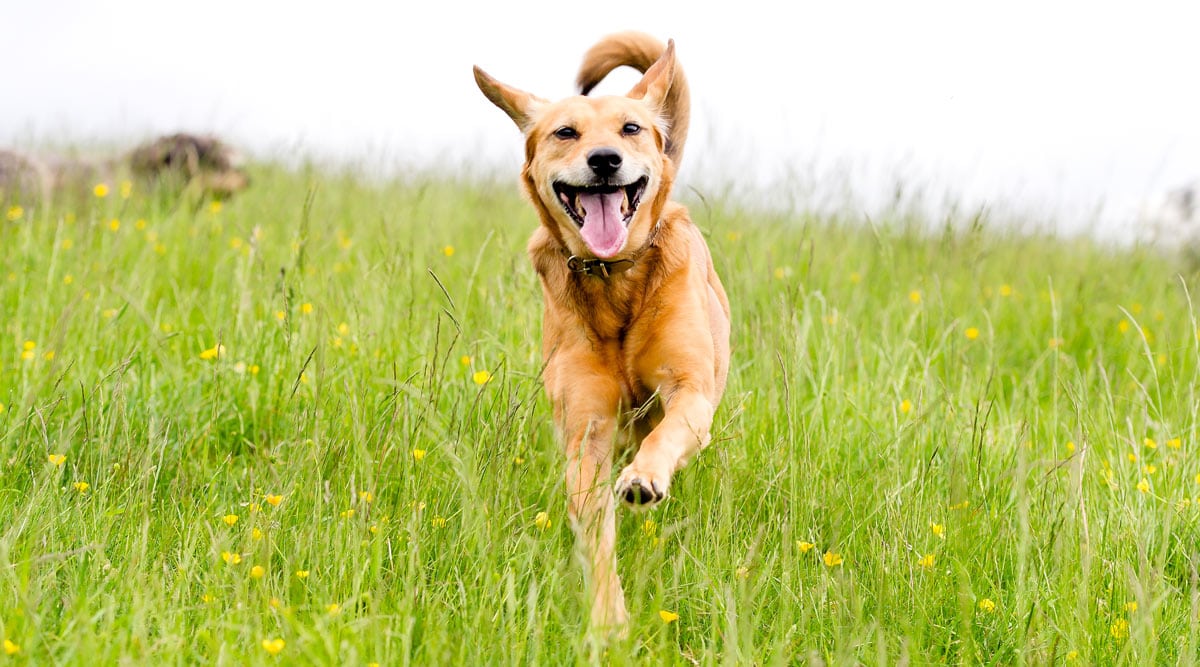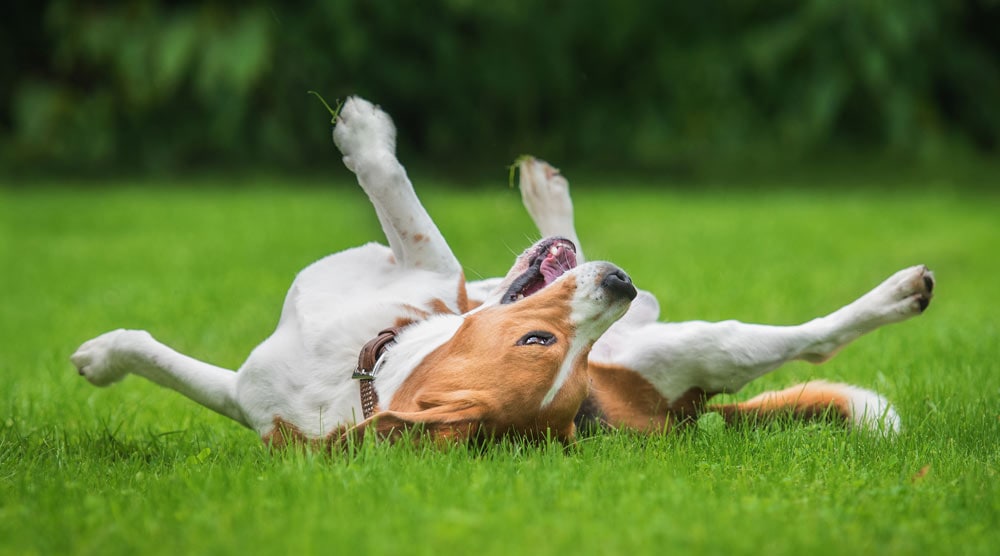Ever wonder why dogs wag their tails? Contrary to popular belief, it’s not always about happiness. In fact, tail wagging can indicate a range of emotions in dogs, from excitement to worry.
In this guide, we’ll explore why dogs wag their tails and how you can understand what they’re saying. Think of it as learning a new language – the language of your furry friend. So, let’s jump in and start wagging!
Contents
Why Do Dogs Wag Their Tails?
The quick answer is that dogs wag their tails to communicate with other dogs or humans.
While many people associate tail wagging with joy or a friendly greeting, this isn’t always the case. In truth, dogs wag their tail to display a range of emotions, from excitement to fear.
This misunderstanding can cause dangerous situations. A dog’s tail might be wagging, but this doesn’t mean that they want to be approached. Dog owners, children, and even some animal professionals(!) may overlook other body language cues when they see a wagging tail, which can heighten the risk of a defensive bite.
But why exactly do dogs use their tails to communicate?
Our four-legged friends have excellent eyes for detecting movement. Over time, it made sense for their tails – which are highly visible on most breeds, even at distance – to evolve into social signalling tools.
Together with facial expressions, ear position, and overall body posture, dogs can use their tails to convey a huge array of emotions. And it’s not just a simple wag – the position of the tail, the speed of wagging, and even the direction of wagging can all change based on the dog’s mood.
Tail Wagging Isn’t The Whole Story
Keep in mind that a wagging tail is just one piece of the puzzle when interpreting a dog’s feelings. We always recommend observing the dog’s overall body language – not just the tail – to truly understand their emotional state.
It’s also worth noting that dogs can experience conflicting emotions (just like us humans!) For example, a dog with a chew toy might want to both welcome a visitor and guard its treat. These conflicting desires can lead to mixed body language signals, which is another reason why a wagging tail doesn’t always signal that the dog wants to interact.
And here’s a fun fact: Dogs very rarely wag their tails when they’re alone, with the exception of when they’re dreaming! This shows that the tail wag is primarily a communication tool.
How to Read And Decode Your Dog’s Tail Wagging
While tail wagging is only one aspect of canine body language, it’s vital to understand how your dog’s tail changes depending on their emotions. This can give you insight into how your dog is feeling in different situations.
Dogs communicate through their tails in three fundamental ways: tail position, wagging speed, and wagging direction.
- Tail Position: This typically indicates the type of emotion your dog is experiencing. High tails usually mean confidence, whereas low tails suggest fear or anxiety. A relaxed position shows your dog is at ease.
- Wagging Speed: This often reflects the intensity of the emotion. A rapid, exaggerated tail wag usually indicates a strong emotional response, while smaller, more tentative wags suggest insecurity.
- Wagging Direction: Surprisingly, the direction of the tail wag matters! Research suggests that tails wagging to the right are linked with positive emotions, while leftward wagging corresponds to negative emotions.
Let’s dive deeper into each of these elements, along with figuring out your dog’s neutral tail position.
The Neutral Position
When a dog is relaxed, its tail rests in a neutral position. It’s vital to know your dog’s neutral tail, as any other body language signals will be in relation to this position.
The neutral position varies depending on the dog’s tail size and shape, which can be curly, straight, short, and more. For instance, many breeds have a tail that hangs towards their back heels when relaxed. However, some have an upright neutral position, while others have coiled tails held close to their bodies.
Tip: For dogs with short tails, you might need to focus more on the base of the tail rather than the tail itself when assessing their body language.
Tail Position and Stiffness

One of the most telling signs in a dog’s body language is tail position. Tucked tails usually indicate anxiety or fear, while higher positions suggest alertness or curiosity. A loosely hanging tail often denotes relaxation.
But there are exceptions to these guidelines. For example, dogs with naturally curved tails over their back may not be able to use their tails to display fear or anxiety in the same way.
Tail stiffness also speaks volumes about your dog’s emotional state. Stiff tails hint at tension, whereas relaxed tails suggest comfort in the situation.
Wag Speed
Wag speed, much like tail position, provides valuable insights into your dog’s emotional state. The faster and more exaggerated the wag, the stronger the emotion.
For example, a wide, swishing wag often signifies a relaxed and happy dog, while smaller wags might indicate uncertainty. An erect tail with minimal wagging or a quick vibrating movement could denote defensiveness. In such cases, it’s best to give your dog space.
Wag Direction
Wag direction is a more subtle way that dogs modify their body language. Studies show that tails wag more to the right during positive emotional states and more to the left during negative ones.
This phenomenon is probably caused by the left brain hemisphere, which is associated with positive emotions, controlling the right side of the body.
Other Body Language Signals
Don’t just rely on tail signs; pay close attention to other body language cues as well. These could include lip licking, yawning, tense facial expressions, hunched postures, and looking or moving away. If you notice any of these signs, it’s best to give your dog some space and respect their emotions.
In the end, remember that tail wagging isn’t always indicative of relaxation or happiness. To understand your furry friend better, pay attention to their overall body language.
A Guide to Tail Wagging and Specific Emotions

As we’ve already mentioned, understanding your dog’s emotions is a key part of strengthening your bond with your furry friend. Here’s a guide to different tail movements and the emotions they’re most commonly associated with.
However, keep in mind that each dog is unique . Learning to read your pet’s tail language takes time, observation, and patience. As you get to know your dog better, you’ll start understanding its unique quirks and signals. It’s all part of the wonderful journey of pet ownership!
Happy
When a dog is happy, you’ll notice its tail held in a relaxed and slightly upright or neutral position. The tail will swish back and forth in a sweeping motion. It’s typically a moderate-speed wag, but as the excitement level rises, so does the wagging speed.
Related Article: Why Dogs Wag Their Tails In Sleep
Excited Greeting
During a greeting, the dog’s tail will often wag in a circular motion, matching their high excitement levels. This ‘helicopter’ wag is often reserved for greeting their owner or a familiar dog.
Frightened or Anxious
A fearful or anxious dog often holds its tail down, and there might be only a small amount of wagging (if any). In some cases, the tail might tuck between the rear legs, a clear indication that the dog is scared or stressed.
Alert
When a dog is alert or aroused, its tail is raised, usually paired with a slight wag. This posture often coincides with stiff ears—an unmistakable sign that something has grabbed the dog’s attention.
Defensive
If a dog feels threatened, its tail becomes stiff and is held vertically or arched over its back. The wagging in this case is fast and stiff, indicating a defensive posture.
Health Issues and Tail Positions
Keeping a keen eye on your dog’s tail not only helps you understand their emotions but can also indicate certain health issues. That tucked tail might be a sign of anxiety, but if it’s a continuous posture rather than situational, it could point towards other potential problems.
Signs of Illness
An unwell dog might carry its tail under the body. This change in tail position can often be accompanied by other tell-tale signs of discomfort or illness, including:
- A hunched posture
- Changes in appetite or drinking habits
- Reluctance to lie down
- Behavioral changes
- Mobility problems
- Excessive panting or salivation
Tail Injuries
Just like any other part of the body, tails can get injured too. If you notice your dog’s tail hanging unnaturally, it could be due to an injury that prevents the tail from being supported in its neutral position.
Limber Tail
A condition known as ‘Limber Tail’ can cause the tail to hang flaccidly. It’s often seen in Retrievers and other sporting dogs, and is thought to be caused by overexerting the tail muscles. If you notice your active dog’s tail seems limp and lifeless, it’s important to get a vet check-up.
Your dog’s tail is an important part of their communication and overall well-being. If you notice any unusual changes in tail position, movement, or other potential symptoms of illness, it’s vital to visit your vet. When it comes to our furry friends, it’s always better to be safe than sorry!
Other Functions of a Dog’s Tail
Dogs’ tails aren’t just for communication. They are also important for a variety of other reasons, including stability and scent spreading. We’ve summarised these below, but you may also want to read our guide to why dogs have tails.
Stability and Balance
Tails initially evolved for stability and balance, especially when dogs run. Acting as a counter-weight, the tail ensures that dogs maintain their equilibrium, no matter how swift or sudden their movements are.
If you’ve ever seen a dog make sharp turns during a chase, you’ll notice their tail swinging to the opposite side, helping them balance.
When swimming, a dog’s tail acts like a rudder, helping them steer and maintain direction. It’s amazing to see how dogs have naturally adapted to various environments using every part of their body, including their tail.
Spreading Scent
The action of tail wagging also aids in spreading a dog’s scent. This is another essential communication tool among dogs. This olfactory messaging allows dogs to claim territories, identify each other, and even signal mating readiness.

The Unethical Practice of Tail Docking
Given all the important functions a dog’s tail serves, it’s clear how vital it is for their wellbeing. That brings us to a contentious issue – tail docking.
Tail docking is the practice of removing a portion of a dog’s tail. It’s a painful procedure that offers no tangible benefits to modern dogs. This alone should be a compelling enough reason to avoid it.
But the implications of tail docking go beyond the physical pain inflicted. It also robs dogs of an essential social tool, making interactions with other dogs and humans more challenging. When a dog’s tail is docked, it becomes much harder for humans and other dogs to read their emotions and intentions.
Tail docking is now illegal in many countries, including the UK, a move we wholly support. A dog’s tail isn’t an aesthetic appendage to be chopped off at the owner’s discretion; it’s a vital part of their physical and social identity. Therefore, we firmly believe this practice should not be carried out anywhere.
Related Questions
Tail wagging is an instinctive canine behavior that starts when the puppy is around three weeks old. However, keep in mind that this could slightly vary depending on the breed.
Dogs with short tails, or even those without tails, can still communicate – but getting their message across is more difficult. They tend to rely more heavily on other forms of body language, like body posture, ear position, facial expressions, and vocalizations.
Summary
In this guide, we’ve taken a deep dive into understanding why dogs wag their tails. We’ve learned that it’s not just a sign of happiness, but a language that our four-legged friends use to communicate a range of emotions from excitement to fear.
We’ve also delved into how to read your dog’s tail wagging, and explored various emotions, health issues related to tail position, and the other functions of a dog’s tail.
Remember, a dog’s tail is much more than just a furry appendage; it’s an important tool for communication and stability. So, let’s keep our eyes on those wagging tails and continue learning the unique language of our canine companions!




